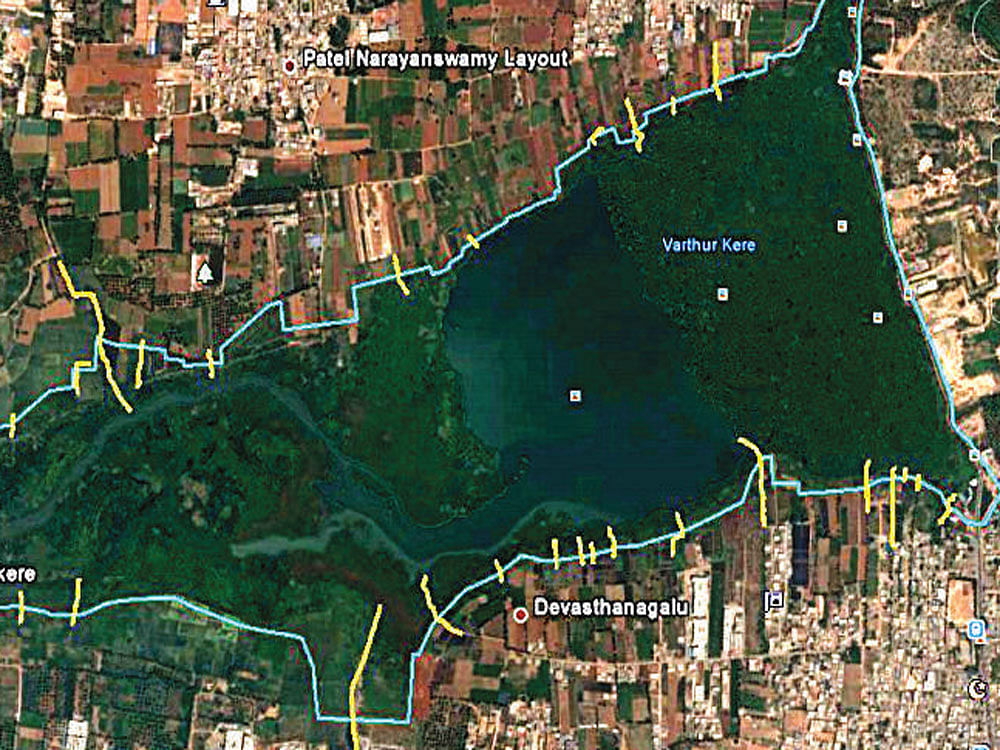
Beware of the vegetables grown on the Varthur lake bed. Deceptive in their fresh, green and leafy avatars, the greens are extremely high on heavy metal content, far beyond the Indian safe limits.
The verdict is not rhetoric. It is based on a recent scientific study arranged by the expert committee on rejuvenation of Varthur and Bellandur lakes.
The findings are alarming. For instance, the lead content in the vegetable samples grown on the waste water towards the lower reaches of Varthur lake was found to be 24-147 mg/kg.
This is way above the prescribed safety limit of 2.5 mg/kg.
Far beyond limits
The chromium content, at 51-131 mg/kg, is also much higher than the limit of 20 mg/kg. Copper levels hover around 89-323 mg/kg, well above the 30 mg/kg limit. The study, conducted by Indian Institute of Science, also places the cadmium levels at 8.5-11 mg/kg, above the 1.5 mg/kg safe mark.
So, the implication is clear. The foam that balloons out of the Varthur lake surface is not just about visual pollution. It is a dramatic sign of the perilous chemical reactions underneath that affect not just the plant and animal life within but also livelihoods far beyond the lake boundary.
Irrigated by contaminated groundwater, washed with the polluted lake water, the greens find their way to markets in Whitefield, Marathahalli, K R Puram, HAL and beyond. Unaware about the high risks, consumers buy the vegetables in plenty. If this is not slow poison, what is?
Vegetable markets
A seller in HAL market confirms that the cabbage, cauliflower, carrot and beetroot in his stall are sourced from Varthur lake side. “It is all part of the game,” is how he dismisses the risks involved. The remark finds an echo in grower Nanjappa’s words: “Our farms are here. Where else do we go for water?”
Analysing borewell water samples in the Varthur lake surroundings, the IISc study had drawn attention to the extremely high contamination. Samples collected from within a distance of one km from the lake’s boundary showed high values of nitrates, coliforms and heavy metals. It was not safe to drink or irrigate.
Early trends
But this is clearly not a recent phenomenon. Thirteen years ago, a study by the Environment Department, Bangalore University had indicated the rising levels of heavy metal contamination in vegetables grown in the vicinity of Bellandur lake.
Over the last decade, vegetable farms disappeared from Bellandur lake due to massive encroachments by real estate developers, dumping of construction debris and garbage. Farmers sold their lands to realtors. Cultivation shifted to the Varthur lake on the downstream.
But vegetables are not the only contaminated produce emerging out of the Varthur lake-bed. As principal of the Varthur-based K K School, M A Khan informs, the weeds and water hyacinth from the lake are used as fodder by dairy farmers in Gunjurpalya.
Milk contamination
Inevitably, the milk produced by cattle fed on this fodder with high heavy metal content are passed on to children in the vicinity. The toxicity spreads further. “Awareness about this should spread to the community. The dairy farmers should be told to source green fodder from areas away from the lake,” says Khan.
A study conducted by K K School students last year had exposed how vegetables grown in Ramagondanahalli and Siddapura on the Varthur lake periphery are supplied to HAL and City markets. The study had also indicated the direct use of the lake water for the farming.
Despite these investigations, the supply continues unabated. The vegetable growers contend that it is a question of their livelihood. There is no alternative source of water supply besides the lake and the borewells. Khan talks about urging the growers to shift to other forms of agriculture.
Revival attempts
But all these suggestions would make sense only if the attempt to rejuvenate Varthur and Bellandur lakes is taken up simultaneously.
Most of the sewage from Bellandur lake flows untreated to Varthur lake. There is no sewage treatment plant (STP) beyond Marathahalli.
To make matters worse, the storm water canal that links the two lakes is heavily encroached. Sewage is let in directly from apartments and industrial units on its path. The message, articulated by the likes of Khan and other lake activists is clear: Half-measures will just not work.